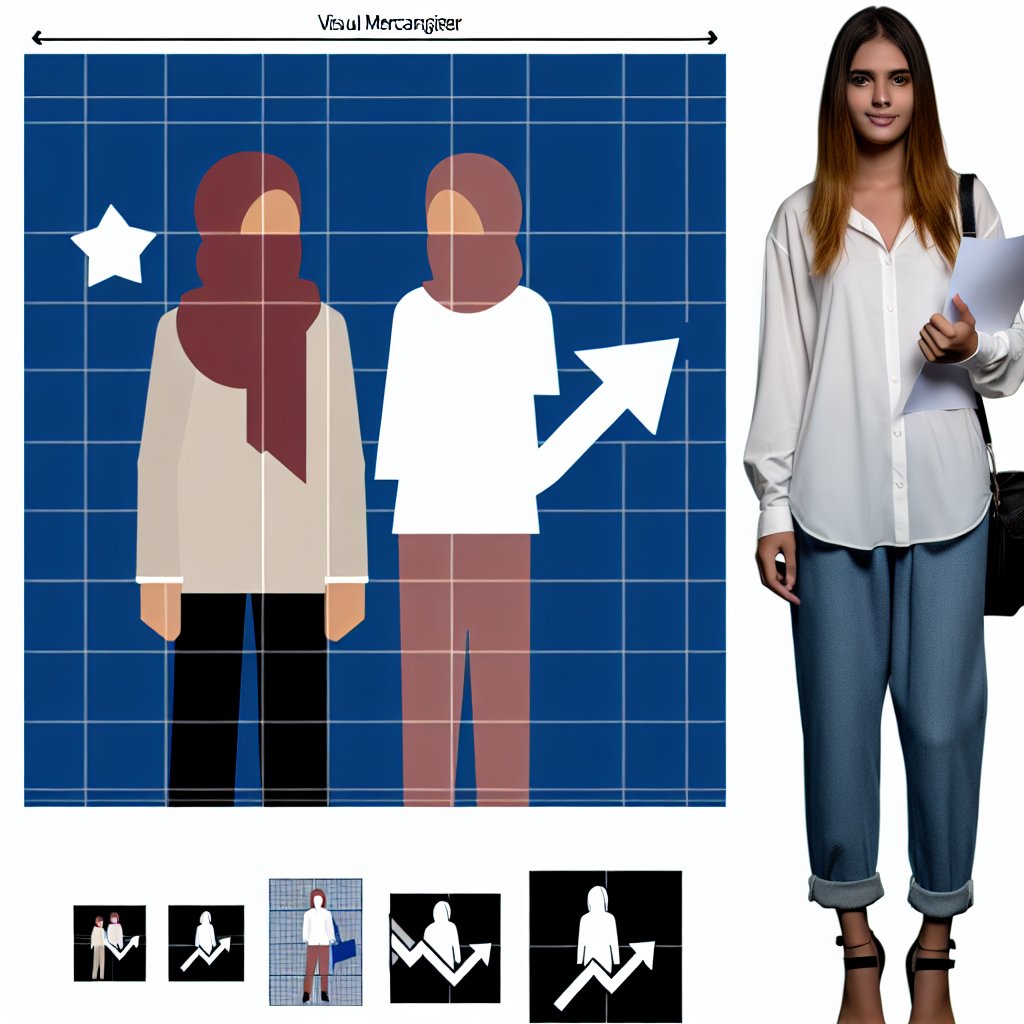The Role of Visual Merchandisers in Enhancing Customer Experience Through Strategic Store Displays
Creating an Inviting Atmosphere
Visual merchandisers design store environments that immediately attract customers.
They arrange products to highlight the store’s unique style and brand identity.
Furthermore, they use colors, lighting, and props to create an engaging atmosphere.
This approach encourages shoppers to enter and explore the store further.
Guiding Customer Journey
Expert visual merchandisers strategically position displays to guide customer flow.
They place high-demand or seasonal items in prominent locations to draw attention.
Moreover, pathway organization maximizes exposure to various product categories.
Therefore, shoppers discover more offerings naturally during their visit.
Enhancing Product Appeal
Visual merchandisers highlight product features through creative display techniques.
They use props and mannequins to showcase versatility and style options.
Additionally, grouping related products creates cross-selling opportunities.
This method helps customers envision how items fit into their lifestyle.
Adapting to Customer Preferences
Merchandisers analyze shopping trends and customer feedback continuously.
They quickly adjust displays to meet evolving tastes and seasonal demands.
Thus, stores remain relevant and feel personalized to their target audience.
Your Personalized Career Strategy
Unlock your potential with tailored career consulting. Get clear, actionable steps designed for your success. Start now!
Get StartedThis dynamic approach strengthens customer loyalty and drives repeat visits.
Collaborating with Marketing and Sales Teams
Visual merchandisers work closely with marketing experts to align campaigns.
They integrate promotional messages into store displays coherently.
In addition, coordination ensures consistent branding across all customer touchpoints.
As a result, the store experience supports broader business goals effectively.
Impact on Sales Performance
Effective visual merchandising positively influences purchasing behavior.
Customers are more likely to make impulse buys when displays are well-crafted.
Moreover, clear and attractive presentations reduce decision fatigue.
Consequently, stores experience higher conversion rates and increased revenue.
How Color Theory and Lighting Attract and Guide Shoppers’ Attention
Influence of Color Theory in Store Displays
Visual merchandisers carefully select colors to evoke specific emotions and reactions.
Warm colors like red and orange create excitement and urgency in shoppers.
Cool colors such as blue and green promote calmness and trust around products.
Moreover, combining contrasting colors helps highlight featured merchandise effectively.
They also use analogous colors to create harmony and a pleasant shopping experience.
Stand Out with a Resume That Gets Results
Your career is worth more than a generic template. Let us craft a resume and cover letter that showcase your unique strengths and help you secure that dream job.
Get HiredColor choices align with brand identity to reinforce customer recognition and loyalty.
Consequently, shoppers feel more engaged and are encouraged to explore the displays.
Strategic Use of Lighting to Enhance Visual Appeal
Proper lighting captures attention and makes products more attractive on shelves.
Spotlights direct focus onto new or high-margin items, increasing their visibility.
Merchandisers employ soft, diffused lighting to create an inviting store atmosphere.
Additionally, lighting temperature influences mood, with warm light fostering comfort.
Cool lighting, on the other hand, emphasizes cleanliness and modernity in displays.
Layered lighting techniques add depth by combining ambient, task, and accent lights.
This approach guides shoppers smoothly through different sections of the store.
Collaboration of Color and Lighting to Guide Shopper Behavior
Together, color and lighting work synergistically to shape customer pathways.
Brightly lit areas with bold colors attract initial attention and invite closer inspection.
Subtle color palettes combined with gentle lighting encourage shoppers to linger.
Visual cues help customers naturally navigate toward promotions or featured collections.
For instance, an illuminated display with vibrant hues draws crowds during sales seasons.
Transform Your LinkedIn for Maximum Impact
Elevate your professional brand with a LinkedIn profile that attracts recruiters, showcases your expertise, and maximizes opportunities. Stand out in your industry with a profile built for success.
Boost ProfileSimilarly, mood lighting paired with coordinated colors reinforces product themes and storytelling.
Ultimately, these techniques increase dwell time and drive higher sales conversions.
Techniques for Creating Thematic and Seasonal Displays That Resonate with Target Audiences
Understanding the Audience and Seasonal Trends
Visual merchandisers begin by researching the preferences of their target audiences.
They analyze seasonal trends to align displays with current customer interests.
Additionally, they monitor cultural events and holidays to create relevant themes.
Combining customer insights with seasonal trends ensures displays feel timely and engaging.
Crafting Thematic Displays
Thematic displays tell a story that captures shoppers’ attention emotionally.
Visual merchandisers select a central concept that reflects brand identity and customer desires.
Then, they choose colors, props, and signage that reinforce the theme.
This coordinated approach helps create a memorable shopping experience.
For example, a beach theme may include sand textures, bright colors, and vacation accessories.
Such details encourage customers to visualize the products in their lives.
Designing Seasonal Displays to Drive Sales
Seasonal displays highlight products relevant to upcoming weather and occasions.
They feature seasonal colors and motifs like autumn leaves or winter snowflakes.
Visual merchandisers strategically place bestsellers and seasonal must-haves prominently.
This placement guides customers toward timely purchases efficiently.
Moreover, limited-time elements create urgency and excitement to buy.
Using Layout and Signage to Enhance Engagement
Merchandisers organize products to maximize visibility and encourage exploration.
They use clear, concise signage to communicate deals and product benefits quickly.
Additionally, directional cues like arrows or footprints lead shoppers through the display.
This flow increases interaction with featured items and boosts overall sales.
Leveraging Color Psychology and Lighting Effects
Colors evoke emotions that influence shopping behavior positively.
Warm colors, like red and orange, stimulate energy and impulse buying.
Cool tones create a calming atmosphere suitable for luxury or wellness products.
Proper lighting highlights key areas and adds depth to displays effectively.
Refreshing Displays Regularly to Maintain Interest
Visual merchandisers update displays frequently to keep content fresh and relevant.
They introduce new props, rearrange products, and adjust themes as seasons change.
This practice prevents shopper fatigue and encourages repeat visits consistently.
Collaborating with Marketing and Sales Teams
Successful displays often result from teamwork between merchandisers and marketers.
Marketing insights guide theme selection and promotional messaging for coherence.
Sales data helps focus on high-demand products and optimal placements.
Collaboration ensures displays align with broader business goals efficiently.
- Keep the target audience at the core of every design decision.
- Incorporate sensory elements such as textures and scent to deepen engagement.
- Balance creativity with clarity to avoid overwhelming shoppers.
- Track performance metrics of displays to refine future strategies.
Gain More Insights: The Importance of Call Center Agents in Enhancing Customer Experiences
The Importance of Product Placement and Focal Points in Driving Impulse Purchases
Influence of Strategic Product Placement
Visual merchandisers carefully plan product placement to attract customers’ attention effectively.
They position popular and seasonal items in high-traffic areas to capture shopper interest quickly.
Furthermore, placing complementary products together encourages customers to consider additional purchases.
This strategy increases the likelihood of impulse buying without appearing pushy.
Moreover, placing products at eye level ensures they are easily noticed by most customers.
Creating Impactful Focal Points
Visual merchandisers design focal points that draw shoppers toward specific areas of the store.
They use lighting, color contrast, and space arrangement to highlight featured products.
For example, a vibrant display near the entrance can rapidly engage passersby and invite them inside.
Additionally, rotating focal points keeps the store fresh and encourages repeat visits.
Effective focal points guide customers naturally through the store layout, increasing exposure to more products.
Techniques That Drive Impulse Purchases
Impulse purchases often result from emotional triggers and sudden visual appeal.
Merchandisers use eye-catching signage and clear pricing to encourage quick decisions.
They place small, attractive items near checkouts to capitalize on last-minute buying impulses.
Moreover, grouping related products with promotional offers motivates customers to add more to their carts.
Consistently, thoughtful product arrangement plays a vital role in boosting overall sales performance.
You Might Also Like: The Life of a Mystery Shopper: Evaluating Retail Performance
Utilizing Space Effectively to Maximize Product Visibility and Store Flow
Optimizing Store Layout for Better Visibility
Visual merchandisers carefully analyze store layouts to maximize product exposure.
They strategically arrange fixtures to highlight key product categories.
Moreover, they ensure high-demand items are placed in easily reachable areas.
This approach attracts customer attention and encourages browsing.
By doing so, merchandisers boost the chances of impulse purchases.
Creating Clear and Inviting Store Pathways
Store flow impacts shopping behavior significantly.
Visual merchandisers design clear pathways that guide shoppers naturally.
They avoid clutter to prevent obstructing customer movement.
Consequently, customers feel comfortable exploring various sections.
Effective flow increases the time shoppers spend in the store.
Balancing Product Density and Space
Merchandisers balance between overcrowding and empty spaces.
They use moderate product density to maintain visual appeal.
Open spaces offer breathing room and highlight featured products.
Additionally, focused displays reduce shopper overwhelm and confusion.
This balance enhances overall shopping experience and conversions.
Leveraging Vertical and Horizontal Space
Vertical space often goes underutilized in many stores.
Merchandisers use shelving and displays to stack products effectively.
This strategy frees up floor space and elevates product visibility.
Horizontal displays complement vertical arrangements to create dynamic presentations.
Together, they optimize the total available space efficiently.
Incorporating Flexible Display Solutions
Flexible fixtures allow merchandisers to adjust displays quickly.
They use mobile shelving and modular units to adapt to inventory changes.
Moreover, this flexibility supports seasonal promotions and new launches.
It keeps the store environment fresh and engaging for returning customers.
Therefore, flexibility in displays drives ongoing interest and sales growth.
Discover More: The Role of Account Executives in Managing Key Business Clients
Incorporating Digital Elements to Engage Modern Consumers
Creating Dynamic and Immersive Experiences
Visual merchandisers integrate digital technology to make store displays more captivating.
They use high-resolution screens to showcase rotating product features and promotions.
Interactive videos draw customers’ attention and encourage longer in-store engagement.
Moreover, dynamic lighting synced with digital content creates an immersive shopping atmosphere.
These techniques help modern brands stand out in crowded retail environments.
Utilizing Interactive Displays for Customer Engagement
Interactive displays invite consumers to explore products in a hands-on way.
Touchscreen kiosks provide instant product information and personalized recommendations.
Some stores incorporate augmented reality features to visualize product uses or styles.
These tools transform passive shoppers into active participants, boosting interest and loyalty.
Additionally, interactive elements collect valuable data to refine marketing strategies.
Strategies for Seamlessly Integrating Technology
Blending Digital and Physical Components
Successful merchandisers blend digital displays with traditional store aesthetics smoothly.
They choose technology that complements product themes and store branding effectively.
For example, luxury boutiques use elegant digital frames to display seasonal collections.
Meanwhile, casual retailers incorporate playful digital signage focused on promotions.
This careful integration enhances shoppers’ experiences without overwhelming them.
Training Staff to Support Digital Engagement
Staff training ensures that employees assist customers with digital tools confidently.
Team members become familiar with screen functions and troubleshooting basics.
They also guide customers on interacting with AR and product information kiosks.
This support helps minimize frustration and maximizes digital display benefits.
Ultimately, knowledgeable staff increase conversions and customer satisfaction.
Benefits of Engaging Modern Consumers Digitally
Increasing Foot Traffic and Sales
Digital and interactive displays attract more visitors by offering novel experiences.
They make stores destinations for discovery beyond simple purchasing.
As a result, foot traffic grows, driving higher sales volume naturally.
Furthermore, customers tend to spend more time browsing and exploring.
This increased engagement leads to better cross-selling opportunities.
Enhancing Brand Perception and Loyalty
Innovative displays position brands as forward-thinking and customer-focused.
They strengthen emotional connections by providing personalized shopping moments.
Interactive technologies also encourage customers to share experiences on social media.
Thus, brands gain organic promotion and foster lasting loyalty.
Ultimately, this digital engagement supports sustainable growth in retail markets.
Explore Further: How Store Supervisors Balance Operations and Customer Satisfaction

Collaboration between Visual Merchandisers and Marketing Teams
Aligning Store Visuals with Brand Campaigns
Visual merchandisers work closely with marketing teams to create cohesive store displays.
This collaboration ensures that visuals reflect current brand campaigns accurately.
By doing so, customers experience a consistent brand message both in-store and online.
Effective communication between teams helps identify key promotional themes early.
Moreover, it allows visual merchandisers to tailor displays that highlight campaign priorities.
Together, they coordinate timing for display changes to match marketing schedules.
Integrating Creative Ideas to Enhance Campaign Impact
Marketing specialists share campaign objectives and creative concepts with visual merchandisers.
Consequently, merchandisers translate these ideas into tangible in-store experiences.
They select props, signage, and layouts that amplify the campaign’s visual appeal.
Likewise, feedback loops between teams refine displays based on customer interaction insights.
This dynamic teamwork maximizes both visual engagement and campaign effectiveness.
Coordinating Seasonal and Product Launch Displays
Collaborative planning helps synchronize product launches with seasonal marketing efforts.
Marketing teams provide advance details on upcoming promotions and product features.
Visual merchandisers develop displays that spotlight new items compellingly.
They arrange products and visuals to catch customers’ attention upon arrival.
Therefore, this teamwork accelerates customer awareness and drives sales growth.
Benefits of Cross-Department Collaboration
- Enhances brand consistency across all customer touchpoints.
- Facilitates timely updates to store displays in response to market trends.
- Improves overall customer engagement through targeted visual storytelling.
- Streamlines resource allocation by aligning creative and operational efforts.
- Encourages innovation through diverse perspectives and expertise.
Ultimately, collaboration between visual merchandisers and marketing teams transforms store displays into powerful sales drivers.
Measuring the Impact of Visual Merchandising on Sales Performance and Customer Behavior
Analyzing Sales Data to Evaluate Effectiveness
Visual merchandisers collaborate closely with sales analysts to track performance changes.
They compare sales figures before and after new displays launch.
Significant increases in product sales often indicate successful merchandising strategies.
Additionally, fluctuations in overall store revenue highlight broader impacts.
Furthermore, seasonal campaigns provide valuable data for comparative analysis.
Regular monitoring helps identify trends linked to visual presentations.
Advanced software tools allow detailed tracking of product-specific sales shifts.
Observing Customer Behavior and Engagement
Experts study how customers interact with store displays over time.
Cameras and sensors help measure foot traffic near featured areas.
Longer engagement times signal greater attraction to visual setups.
Moreover, customer surveys gauge shopper satisfaction with store ambiance.
Eye-tracking technology reveals which display elements capture attention first.
Retail consultants often conduct in-person observations to note buying triggers.
Data from loyalty programs supplements understanding of repeat purchasing patterns.
Using Feedback to Refine Merchandising Strategies
Store managers collect input from frontline staff about customer reactions.
They also review social media comments regarding store layout and visuals.
Focus groups contribute insights on aesthetic preferences and shopping ease.
Consequently, visual merchandisers adjust designs to better meet customer needs.
Iterative improvements ensure displays remain fresh and relevant.
This feedback loop fosters continuous enhancement of sales performance.
Key Performance Indicators for Visual Merchandising
- Sales volume increases of specific promoted items.
- Conversion rates from store visits to purchases.
- Average transaction value during display campaigns.
- Customer dwell time in targeted store zones.
- Engagement levels via digital or interactive displays.
By analyzing these indicators, companies like Meridian Retail Consulting optimize visual impact.
Ultimately, measurable results demonstrate how merchandising drives consumer behavior.
Adapting Visual Merchandising Strategies to Evolving Retail Trends and Consumer Preferences
Recognizing Shifts in Consumer Behavior
Visual merchandisers must monitor changing shopper habits regularly.
They analyze data from sales reports and customer feedback carefully.
Furthermore, they stay updated with lifestyle trends influencing buying decisions.
For example, the rise of eco-conscious consumers demands sustainable display materials.
Thus, visual displays reflect shoppers' growing interest in ethical products.
Incorporating Digital Elements into Displays
Technology has reshaped how customers interact with store environments.
Visual merchandisers integrate digital screens to provide dynamic messaging effectively.
They also use interactive kiosks that engage and inform potential buyers directly.
Additionally, QR codes placed within displays connect in-store and online experiences.
This hybrid approach enhances customer engagement and modernizes brand presence.
Aligning Store Layouts with Omnichannel Shopping
Visual merchandising adapts to support seamless cross-channel purchasing journeys.
Displays now highlight click-and-collect options and easy returns explicitly.
Merchandisers guide customers visually to digital service points within physical spaces.
They design flow patterns that encourage browsing while accommodating mobile shoppers.
In this way, stores remain relevant despite ecommerce growth pressures.
Emphasizing Personalization and Local Relevance
Retailers use visual merchandising to connect personally with diverse audiences.
Merchandisers tailor displays based on regional preferences and seasonal occasions.
Targeted messaging and culturally relevant props build stronger emotional ties.
Moreover, personalized product arrangements increase perceived value and attention.
Consequently, customers feel seen, boosting loyalty and repeat visits.
Utilizing Sustainable and Flexible Display Solutions
Current trends encourage eco-friendly materials in fixtures and signage.
Merchandisers select recyclable and reusable components to reduce waste.
They also design flexible displays to adapt quickly to changing products or promotions.
This agility allows stores like Brighton & Oak Interiors to stay fresh and relevant.
Ultimately, such practices strengthen both environmental responsibility and customer appeal.
Case Studies of Successful Visual Merchandising Transformations
Revitalizing Fashion Boutique Displays
At The Bramble Closet, visual merchandiser Emily Porter redesigned the window displays.
She introduced dynamic themed setups that aligned with seasonal trends.
Additionally, Emily incorporated lighting techniques to highlight key products.
Consequently, foot traffic increased steadily within weeks.
The boutique experienced a 30% boost in sales during the following quarter.
Enhancing Electronics Store Layout
InnovateTech Electronics hired visual specialist Marcus Liu to revamp their store layout.
Marcus created interactive product stations to engage customers effectively.
This strategy encouraged shoppers to try devices firsthand.
As a result, customer dwell time increased significantly.
Subsequently, InnovateTech reported a 25% rise in average purchase value.
Transforming Grocery Store Product Displays
FreshFields Market collaborated with visual expert Sara Goldberg for a display overhaul.
Sara positioned fresh produce at the entrance with bright colors and clear signage.
Moreover, she arranged complementary items nearby to inspire meal ideas.
This thoughtful arrangement improved customer flow throughout the store.
Ultimately, FreshFields saw a 20% increase in sales of fresh goods.
Creating Eye-Catching Bookstore Windows
At Willow & Reed Books, designer Lucas Grant refreshed seasonal window displays.
Lucas used storytelling themes that resonated with local community interests.
In addition, he incorporated 3D props and layered visuals for depth.
These elements attracted increased attention from passersby.
Consequently, Willow & Reed experienced a 35% surge in monthly sales.
Optimizing Home Decor Store Presentation
Coastal Living Interiors recruited visual merchandiser Priya Desai to enhance displays.
Priya grouped products into lifestyle vignettes showing functional use.
This approach helped customers visualize items in their own homes.
Furthermore, she used color coordination to create appealing visual harmony.
Sales improved by 28% following these impactful changes.
Additional Resources
Did you know that efficient merchandising can transform your store’s …
Setting the future of digital and social media marketing research …




